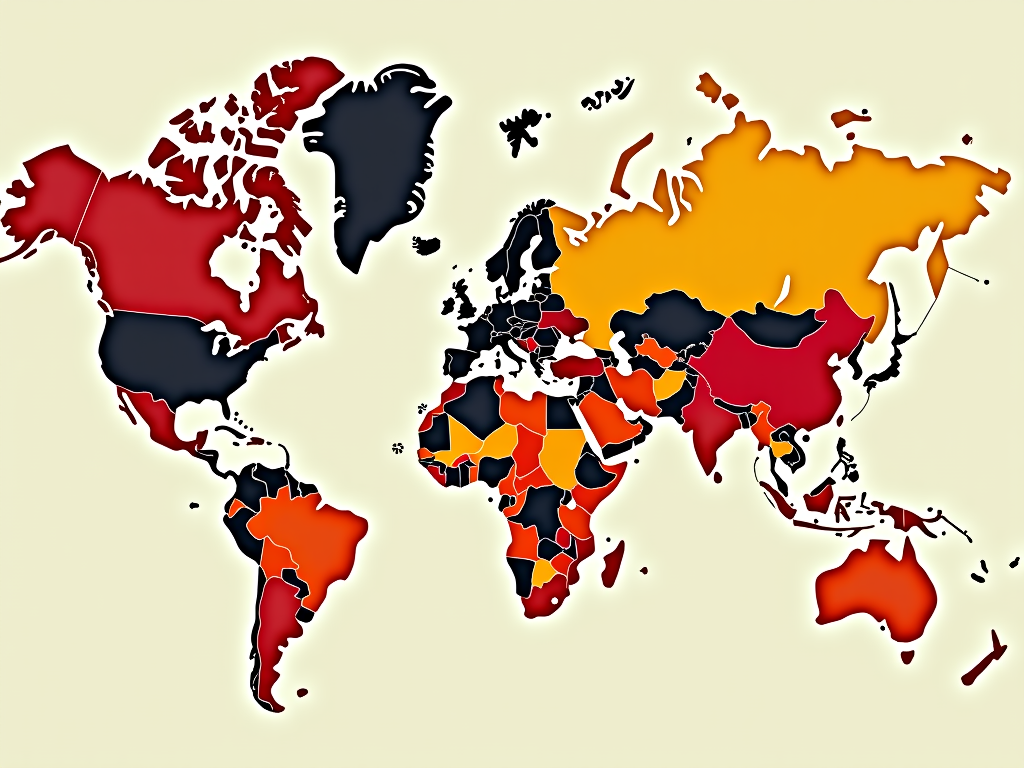The Trump administration is finalizing a new travel ban that would restrict entry to the United States for citizens from as many as 43 countries, dramatically expanding the scope of similar restrictions implemented during President Trump’s first term. According to internal documents and officials familiar with the plans, the proposed ban classifies nations into three tiers based on perceived security threats and vetting capabilities.
Three-Tier System Would Create Varying Levels of Restrictions
The draft proposal, which was first reported by The New York Times and later confirmed by Reuters, divides countries into “red,” “orange,” and “yellow” categories, each facing different levels of restrictions. While the White House has not officially confirmed the details, the list was reportedly created by the State Department several weeks ago in response to a January executive order.
“Wouldn’t that be a foolish thing for me to disclose?” President Trump responded when questioned about which nations might be included in the revised list during a March 12 press briefing.
According to officials familiar with the internal document, the 11 nations categorized as “red” would face an outright prohibition on entering the United States. This list includes Afghanistan, Bhutan, Cuba, Iran, Libya, North Korea, Somalia, Sudan, Syria, Venezuela, and Yemen 38.
Nations in the “orange” tier, including Belarus, Haiti, and Russia, would face significant visa restrictions rather than a complete ban. Citizens from these countries would be required to undergo “mandatory in-person interviews” to obtain visas for travel to the U.S. 5.
The “yellow” category comprises 22 countries that would be given a 60-day period to address the administration’s concerns about “deficiencies” in their vetting processes, or risk being elevated to a higher tier with more severe restrictions 5.
Expansion of Previous Travel Ban Policies
This new initiative represents a significant broadening of Trump’s controversial first-term policy, which primarily targeted seven predominantly Muslim countries.
“Remember the famous travel ban? We didn’t take people from certain areas of the world,” Trump said during a campaign event in September 20241.
The original travel ban, established through Executive Order 13769 in January 2017 and known as “Protecting the Nation From Foreign Terrorist Entry Into the United States,” primarily restricted entry for citizens from Iraq, Iran, Libya, Somalia, Sudan, Syria, and Yemen. The initial implementation caused widespread chaos at airports and sparked nationwide protests1.
After several court challenges and revisions, the Supreme Court ultimately upheld a modified version of the ban in 2018. When President Biden took office in 2021, he rescinded Trump’s travel bans, calling them “a stain on our national conscience” and inconsistent with America’s tradition of welcoming individuals of all faiths and beliefs15.

Concerns for Afghan Allies and Refugees
The potential inclusion of Afghanistan on the “red” list has raised particular concerns among veteran groups and refugee advocates, who worry about the fate of Afghans who supported American military operations during the war.
Shawn VanDiver, leader of a nonprofit organization dedicated to resettling Afghans who collaborated with U.S. military forces, indicated that he had been informed by officials that Afghan nationals would be subjected to a complete travel ban2.
“This is the most thoroughly vetted group that has ever existed,” remarked VanDiver in an interview. “It’s astonishing what these individuals endure.” He added that many veterans of the Afghan conflict who supported Trump now feel anger as news of a potential travel ban spreads. “They’re saying, ‘This isn’t what I voted for,'” he noted. “The agreement was to bring our wartime allies home, and they’re simply betraying these individuals.”2
In response to these concerns, organizations like No One Left Behind have raised millions of dollars to arrange flights for Afghan allies before the ban potentially takes effect4.
“There’s a very real chance that they could be sent back to Afghanistan with a U.S. visa in hand, which could be fatal for these allies,” stated Andrew Sullivan, a former Army infantry company commander in Afghanistan4.
Legal Foundation and Timeline
The foundation for this expanded travel ban was established on January 20, 2025, when President Trump signed an Executive Order titled “Protect the United States From Foreign Terror and Other Security and Safety Threats”1.
This order tasked the Secretary of State, the Attorney General, the Secretary of Homeland Security, and the Director of National Intelligence with compiling a report identifying nations with insufficient vetting processes that could warrant a suspension of their nationals’ admission. A 60-day deadline was established for this report, which would place the completion date in mid-March15.
In the executive order, Trump asserted that he was acting to protect American citizens “from aliens who intend to commit terrorist acts, threaten our national security, espouse hateful ideologies, or otherwise exploit immigration laws for malicious purposes”23.
A White House representative informed media outlets that no definitive decision has been reached yet, emphasizing that the list could be altered before it is reviewed by the White House5.
Potential International Reactions
The placement of certain countries on these lists could strain diplomatic relationships. Russia’s inclusion on the orange list, for instance, could potentially complicate Trump’s recent attempts to foster friendlier relations with the nation3.
Officials familiar with the discussions have noted that regional bureaus in the State Department and U.S. embassies worldwide are currently reviewing the draft. They are assessing whether the identified deficiencies in specific countries are accurate and if there are policy considerations—such as maintaining cooperation on other priorities—that might warrant reconsidering certain nations’ inclusion2.
As the administration moves closer to finalizing this expanded travel ban, legal challenges similar to those that followed the 2017 ban may be anticipated, along with potential diplomatic repercussions and humanitarian concerns for those affected by the restrictions.
Citations:
- https://time.com/7268645/trump-travel-ban-2025-reports-countries-at-risk/
- https://www.nytimes.com/2025/03/06/us/politics/trump-travel-ban.html
- https://www.yahoo.com/news/proposed-trump-travel-ban-target-040616663.html
- https://www.nytimes.com/2025/03/13/us/trump-travel-ban-afghan-allies.html
- https://www.the-independent.com/news/world/americas/us-politics/trump-travel-ban-countries-list-b2715762.html
- https://www.nytimes.com/2025/02/15/us/politics/trump-saves-country-quote.html
- https://www.youtube.com/watch?v=3q7RRjKC8eA
- https://www.reuters.com/world/countries-considered-trumps-potential-new-travel-ban-2025-03-15/
- https://www.nytimes.com/live/2025/03/15/us/trump-news
- https://www.reuters.com/video/watch/idRW910515032025RP1?chan=us-news&location=channel-item
- https://www.nytimes.com/2025/03/14/us/politics/trump-travel-ban.html
- https://www.reuters.com/world/us/trump-administration-weighs-travel-ban-dozens-countries-memo-says-2025-03-15/
- https://www.aljazeera.com/news/2025/3/15/trump-administration-mulls-new-travel-ban-that-could-hit-dozens-of-nations
- https://www.nytimes.com/2018/07/01/world/americas/travel-ban-trump-how-it-works.html
- https://www.nytimes.com/2018/06/26/us/politics/supreme-court-trump-travel-ban.html
- https://www.nytimes.com/2017/03/06/us/politics/travel-ban-muslim-trump.html

